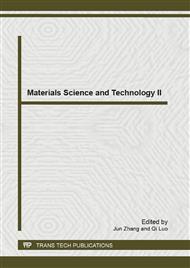p.94
p.98
p.103
p.109
p.113
p.119
p.127
p.132
p.138
Effect of Na2CO3 Addition on the Piezoelectric and Dielectric Properties of Lead-Free (Na0.5K0.5)NbO3-(Na0.5Bi0.5)TiO3 Ceramics
Abstract:
Lead free piezoelectric ceramics 0.98(Na0.5K0.5)NbO3-0.02(Na0.5Bi0.5)TiO3 [abbreviated as 0.98NKN-0.02NB with the addition of 0~1.0 wt% Na2CO3 have been synthesized by the conventional mixed oxide process. The effects of amount of Na2CO3-content on the electrical properties and crystalline structures were investigated. The specimens of 0.98NKN-0.02NBT ceramics added with Na2CO3 maintain an orthorhombic phase. In the case of low Na2CO3 content ( 0.3 wt%), the grain growth became remarkable. The increase of grain size favors improving the piezoelectric properties, which is known as grain size effect. The grain size effect compensates the decrease of the electromechanical coupling factor due to the hard doping effect. For 0.98NKN-0.02NBT ceramics by doping 0.3 wt% Na2CO3, the electromechanical coupling coefficients of the thickness mode kt and the planar mode kp reach 0.51 and 0.33, respectively, after sintering at 1100 °C for 3 h. Moreover, the addition of excess Na2CO3 is a helpful method on ceramic processing to improve the dielectric tangent loss and the mechanical quality factor. Our results show that 0.98NKN-0.02NBT with the addition of 0.3 wt% Na2CO3 is a good lead-free piezoelectric ceramic.
Info:
Periodical:
Pages:
113-118
Citation:
Online since:
July 2013
Authors:
Price:
Сopyright:
© 2013 Trans Tech Publications Ltd. All Rights Reserved
Share:
Citation:


